There’s no denying that paid conversion rates are lower on mobile devices than on desktop. With more than 95% of users accessing Facebook via mobile devices, Facebook lead ads were created to fill that gap and capture these hot leads.
Want to generate more leads? Learn how Facebook leads ads could help you fill the gap.
There’s no denying that paid conversion rates are lower on mobile devices than on desktop. With more than 95% of users accessing Facebook via mobile devices, Facebook lead ads were created to fill that gap and capture these hot leads.
Facebook lead ads are mobile-friendly, budget-friendly ads that can help you reach your audience and acquire more leads – even when they’re on their phones.
But as we know, more leads aren’t a guarantee of good leads.
So, we listed 7 ways to make sure your Facebook lead ads are not only capturing leads, but converting new sales.
Keep reading to learn:
Let’s get stuck in!
Facebook Lead Ads are a great way to encourage a targeted audience to contact your business by requesting a quote, information or more. Essentially, this ad type allows users to qualify themselves as a sales-qualified lead.
This user and mobile-friendly advert enables Facebook users to provide you with contact details and information on the products they’re interested in.
Not only do lead ads allow you to create more leads, but they also allow you to collect customer data for retargeting.
🚀 Pro Tip
There are growing limitations when it comes to retargeting through Facebook thanks to cookies. Learn more about first-party cookies and how to keep tracking users.
Facebook’s lead form ads include a CTA that opens a pre-populated form with any details the users have previously shared on the platform.
These details can be reviewed before submission.
Related: How to track Facebook ads in Google Analytics 4
Generally, Facebook users want to stay on Facebook.
So, there was a clear divide in performance for mobile and desktop users, as mobile users don’t click to visit websites.
By removing this need, you can skip straight to generating leads.
Not sure why you would want to skip sending a user to your website? Here’s why you should be using Facebook lead ads:
Optimised for mobile: We know conversion rates for mobile on paid channels is low. By using a lead form, we’re making data submission quick and easy, especially with pre-population. This enables users to share their details while on the move – and frankly, takes hesitation away meaning more leads for you.
This will be especially useful as more and more users move to mobile.
Fewer steps: The issue we see with other paid campaigns is we might encourage a user to click to our website, but they don’t convert. That user could convert later down the line, but it costs us more time and budget to get them there.
Lead ads are great for getting the user over the line. Less drop off means more conversions, and getting direct data allows you to highly optimise your retargeting.
CRM integration: You can sync your leads to your CRM for immediate follow-up so your sales team will be thanking you.
Form customisation: Not only can you customise your form to ask for the data that’s most important to you, but you can also customise your form for a range of lead generation purposes. Whether you’re looking to create a newsletter subscription, book call-backs or generate quote requests.
Table of Contents
Before you create an ad campaign, you should have an objective in mind. Here are a few ways that you can use lead form ads.
Collect email sign-ups: Want to build a database of interested prospects? You can use lead form ads to grow newsletter subscription and use email to market to those leads.
General enquiry forms: Want to get straight to sales? Collect enquiries from potential customers, asking them relevant questions so your sales team know as much about them as possible for a seamless approach.
Offer deals: Entice users to complete your lead form by offering a deal or promotion in exchange for their details. This obviously works better for warmer leads but can be a great way to get repeat customers.
Now we know what Facebook’s lead forms are and when to use them, let’s learn how to create them. Luckily, they’re simple to set up so you can get started in mere minutes!
Navigate to Ads Manager, and click ‘new campaign’.
Once in the ads creator, select ‘lead generation’ as your marketing objective.
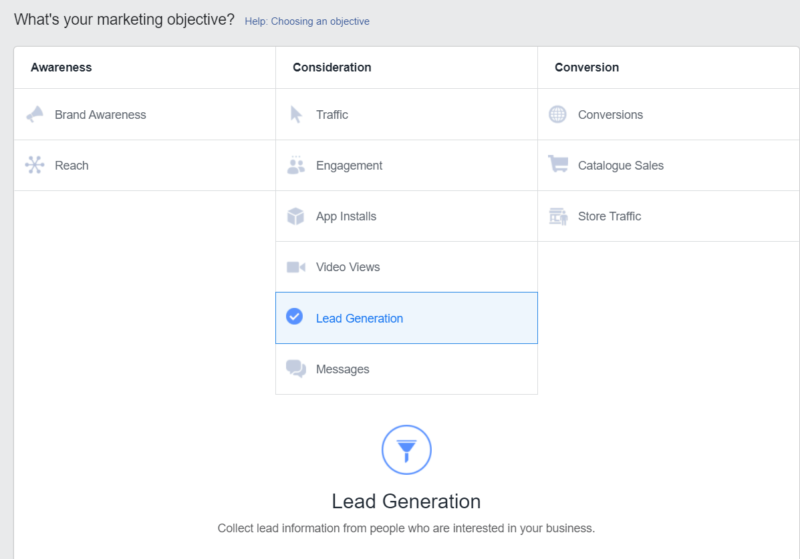
Follow the usual steps, naming your campaign and setting a budget.
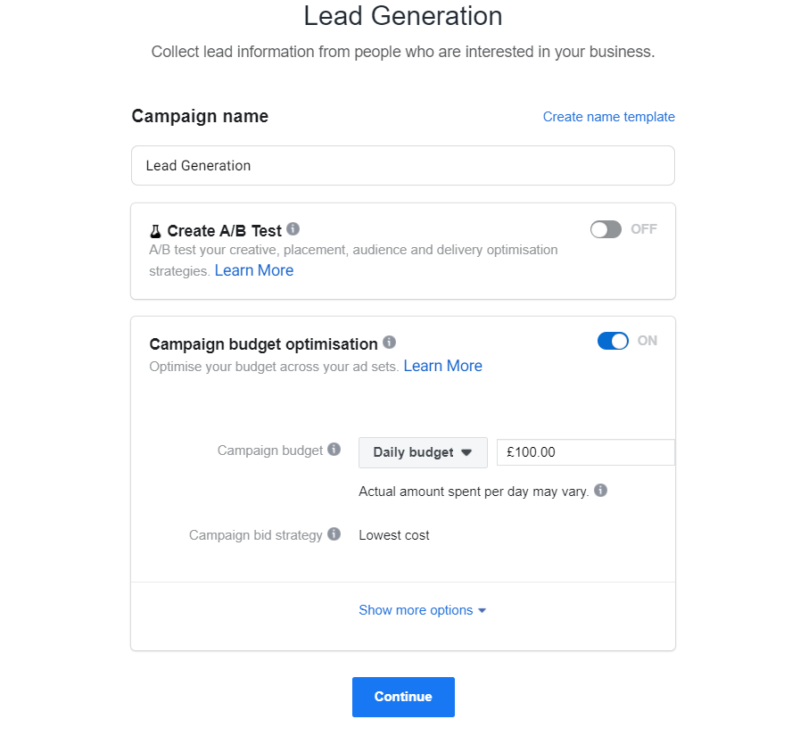
Then, it’s time to target your audience. Set your audience up to be as targeted as possible. This will help to drive more leads.
From there, you can create your ad.

Make sure to make it as compelling as possible. Skip to our 7 steps to create a lead ad that converts, for more tips on how to do that.
Then, it’s time to create the form.
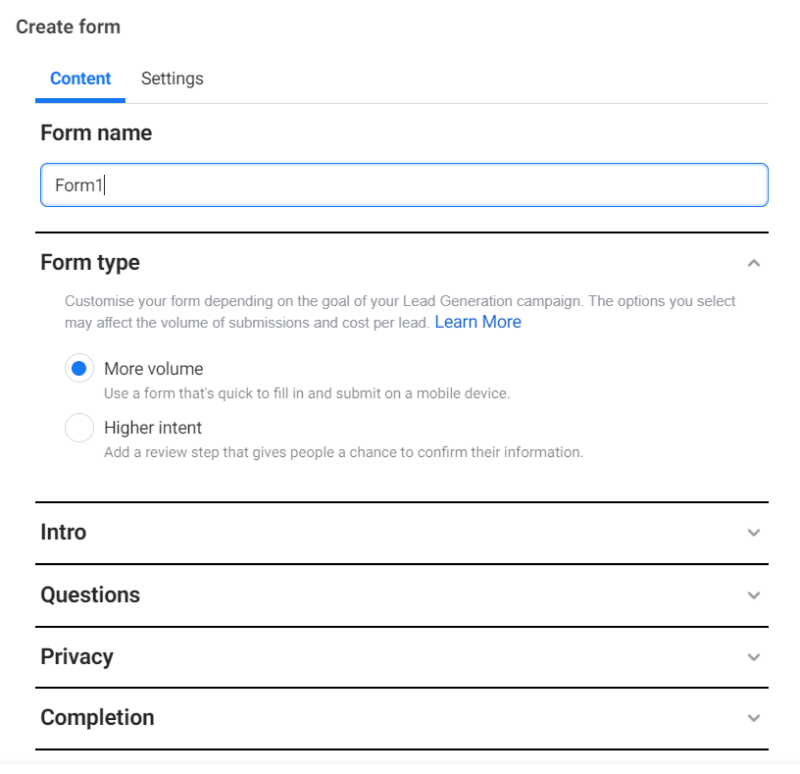
The form editor is super simple to use and it shows you a live version of what you’re creating as you create it too.
Set all the graphic elements of the form. Then, select your questions.
Remember to ask for all the details you need. Depending on what your form is being used for, the data you need to ask for will change.
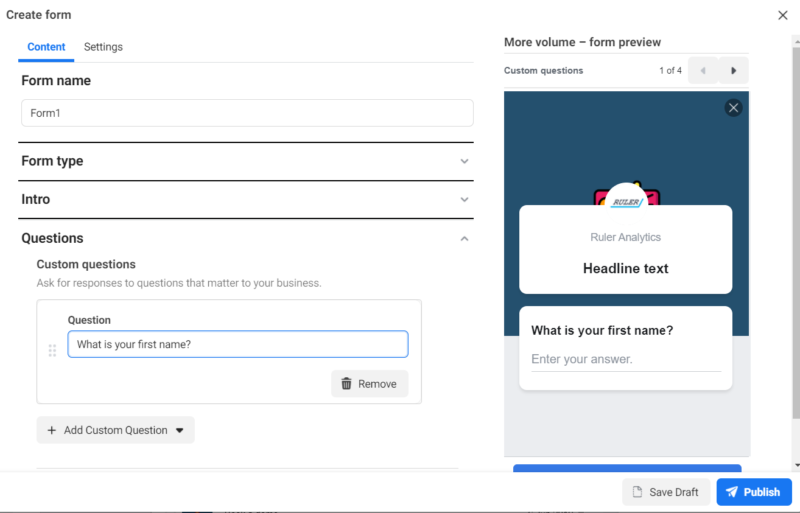
If you’re creating a subscription form for a newsletter, then you might just ask for name, email address and interests. If you’re trying to generate quote requests, then you’ll need more contact information, as well as questions to find out what product the user is interested in.
Once your form and ad is created, you’re ready to go live.
Set publish, and watch the leads come rolling in!
Ok, so creating leads isn’t quite as easy as just watching them roll in.. So, to make the most out of your Facebook lead form, we shared seven ways to generate more leads.
So whether you’re a novice at lead ads, or a seasoned pro, these tips will help you ensure that you’re getting the most out of your budget.
Just like other paid campaigns, creating lookalike audiences is always a great way to start off your campaign. By using data from real customers, you can create lookalike audiences and Facebook will do the rest.
To do this, upload a database of your customers, and then create a custom audience by using 1-2% lookalike audience creation. This is a great prospecting option. Read on for retargeting tips.
Given Facebook lead forms directly convert users into leads with no other steps, this type of ad is great for retargeting.
For retargeting, upload a database of your leads.
You can target directly to them, and also create a lookalike audience just like you did for your customers.
This is a great way to capitalise on leads sitting in your database.
With recent explosions in data breaches from large and small companies alike, users are unsurprisingly more careful with their data.
As such, generating leads via Facebook’s lead forms can be tricky.
To get data from even the most interested prospect, you need to give them something they want in return.
A lot of lead ads offer free content in exchange for details.
This is great for businesses looking to expand their reach to relevant audiences.
However, if you’re more bespoke, then you might want to offer a free quote or consultation.
Here are some other options to consider:
Facebook lead forms give you a wealth of editability in your questions.
So, picking the right ones is essential to make sure you get the information you need.
The information (and therefore questions) you need to ask will massively depend on your business goals and the purpose of your lead ad.
Here’s how Facebook Business has split out the types of lead form ads and the questions you need to ask for each:
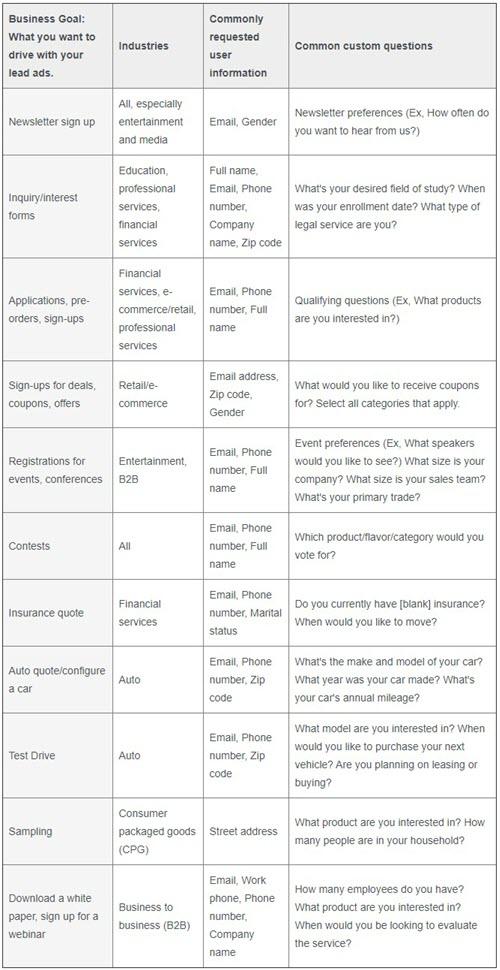
Remember, less is more when it comes to lead forms, so try to keep them to the point.
A customised thank you page is a great way to keep your new leads engaged. You can choose from three call to actions:
Head to the completion section of the form creator to edit the final page.
Now your form is set up to convert prospects into leads, your next step is to turn those leads into customers.
Remember, with current technology, users expect immediate responses. So, when a user fills a lead form ad, don’t forget to respond to them.
Now you have their details, provide them valuable information, or whatever they requested from your form.
If you set up a form to generate subscribers, ensure you have an automatic email for new subscribers.
Or, if you’re generating quotes, follow up with the lead the next day with their personalised quotation.
Last but not least, reporting. Reporting is so important to understand the true success of your campaigns.
Return on ad spend is a key metric when setting up ad campaigns.
While Facebook’s lead form adverts will directly tell you how many leads you’re generating, how will you track how many of those convert into customers?
Chances are, this isn’t the only campaign, or marketing channel, that the lead has been influenced by.
But how can you see how channels and campaigns work together to progress leads?
Marketing attribution tools connect your sales to your marketing efforts.
Related: Guide to marketing attribution
That means you’ll be able to see how many leads your advert drives, but also, how many sales and how much revenue they generate too.
🚀 Pro Tip
Need even more insight? Marketing mix modelling can help get you impression-level data on your channels and ads.
Learn more about marketing mix modelling
So, now you know how to set up a Facebook lead ad and how to optimise it so you can concentrate on generating leads and revenue.
If you want to close the loop between your marketing and your sales data, then get started today by booking a demo of Ruler Analytics.